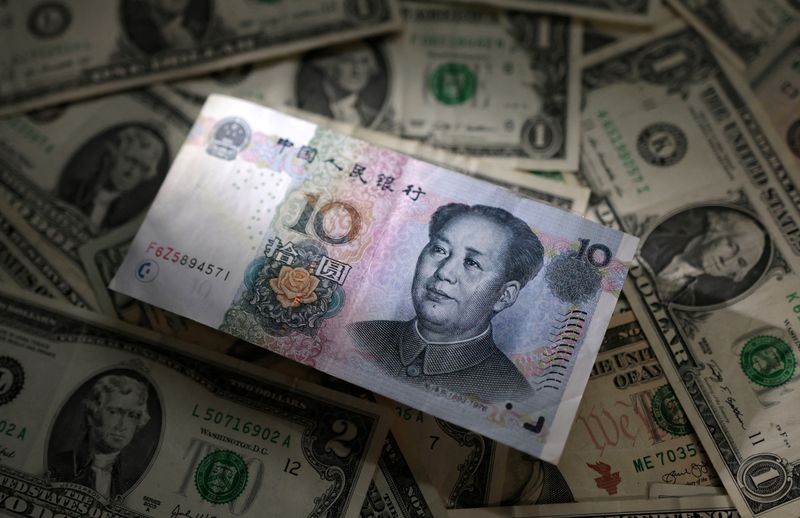Forex
Dollar falls after stronger-than-expected retail sales data, yuan falls to 9-month low


© Reuters. FILE PHOTO: Chinese Yuan and U.S. dollar banknotes are seen in this illustration taken March 10, 2023. REUTERS/Dado Ruvic/Illustration
By Hannah Lang, Joice Alves and Samuel Indyk
WASHINGTON/LONDON (Reuters) – The was lower after data showed U.S. retail sales increased more than expected in July, while the yuan sank to a nine-month trough on Tuesday after China’s central bank unexpectedly cut key policy rates.
U.S. retail sales jumped 0.7% last month, the Commerce Department said, demonstrating that demand has remained resilient despite the Federal Reserve’s aggressive interest rate hikes to tame inflation, thanks to strong wage gains from a tight labor market.
The dollar index, which measures the currency against six peers including the euro and sterling, dropped 0.194% to 102.920 after hitting a 1-1/2-month high at 103.46 on Monday.
The dollar gained over 0.5% against the to a nine-month high of 7.3307 as the People’s Bank of China (PBOC) cut its rates in an effort to boost a sputtering economic recovery.
Punctuating those worries, Chinese data on industrial output, retail sales and investment released shortly after the PBOC’s rate cut showed unexpected slowdowns.
“I think the strong U.S. sales data provided some relief to the negative surprise in the Chinese data, so this has pushed risk back up,” said John Velis, head of Americas macro strategy at BNY Mellon (NYSE:) Markets in New York.
YEN WATCH
Against the yen, the U.S. dollar pushed to a fresh nine-month high of 145.865, before dropping to a session low at 145.25. It was last trading at 145.28 per yen.
Traders are looking for any hints of intervention, after the dollar’s surge above 145 last autumn triggered the first yen buying by Japanese officials in a generation.
“We could definitely see more verbal interventions, but unless the move is driven by speculators and the yen is out of sync with other currencies, maybe there’s still some way to go before the actual intervention comes,” said Shinichiro Kadota, a currency strategist at Barclays (LON:).
“In any case, I think concerns about intervention is definitely putting a lid on the dollar-yen around these levels.”
Japanese Finance Minister Shunichi Suzuki said on Tuesday that authorities are not targeting absolute currency levels when it comes to intervening in the market.
Elsewhere, sterling rose after data showed British basic wages grew at a record pace, adding to the Bank of England’s inflation worries.
The pound was last 0.38% higher at $1.27335 following data showing British wages excluding bonuses were 7.8% higher than a year earlier in the three months to June. That represented the highest annual growth rate since comparable records began in 2001.
The UK unemployment rate, however, unexpectedly rose to 4.2% from 4.0%, but money market traders still expect the Bank of England to raise rates by at least 25 basis points next month on worries high pay growth will lead to second-round effects on inflation.
The euro was last up 0.28% to $1.0935.
The Russian rouble gave up early gains after Russia’s central bank lifted its key interest rate by 350 basis points to 12% at an emergency meeting to try and halt the currency from weakening past 100 to the dollar after a public call from the Kremlin for tighter monetary policy.
========================================================
Currency bid prices at 10:30AM (1430 GMT)
Description RIC Last U.S. Close Pct Change YTD Pct High Bid Low Bid
Previous Change
Session
Dollar index 102.9200 103.1400 -0.19% -0.551% +103.2800 +102.8000
Euro/Dollar $1.0935 $1.0905 +0.28% +2.05% +$1.0952 +$1.0896
Dollar/Yen 145.2700 145.5650 -0.18% +10.83% +145.8600 +145.2150
Euro/Yen 158.86 158.71 +0.09% +13.23% +159.3300 +158.5500
Dollar/Swiss 0.8764 0.8783 -0.18% -5.18% +0.8796 +0.8745
Sterling/Dollar $1.2733 $1.2685 +0.38% +5.29% +$1.2740 +$1.2680
Dollar/Canadian 1.3484 1.3463 +0.19% -0.45% +1.3500 +1.3440
Aussie/Dollar $0.6472 $0.6488 -0.23% -5.04% +$0.6522 +$0.6456
Euro/Swiss 0.9582 0.9578 +0.04% -3.16% +0.9596 +0.9568
Euro/Sterling 0.8585 0.8594 -0.10% -2.93% +0.8609 +0.8583
NZ $0.5973 $0.5975 -0.05% -5.95% +$0.5996 +$0.5957
Dollar/Dollar
Dollar/Norway 10.5010 10.4770 +0.32% +7.10% +10.5200 +10.4510
Euro/Norway 11.4834 11.4223 +0.53% +9.43% +11.4915 +11.4014
Dollar/Sweden 10.8142 10.7689 +0.52% +3.90% +10.8677 +10.7734
Euro/Sweden 11.8261 11.7648 +0.52% +6.07% +11.8670 +11.7565

 Forex3 years ago
Forex3 years agoForex Today: the dollar is gaining strength amid gloomy sentiment at the start of the Fed’s week

 Forex3 years ago
Forex3 years agoUnbiased review of Pocket Option broker

 Forex3 years ago
Forex3 years agoDollar to pound sterling exchange rate today: Pound plummeted to its lowest since 1985

 Forex3 years ago
Forex3 years agoHow is the Australian dollar doing today?

 Cryptocurrency3 years ago
Cryptocurrency3 years agoWhat happened in the crypto market – current events today

 World3 years ago
World3 years agoWhy are modern video games an art form?

 Commodities3 years ago
Commodities3 years agoCopper continues to fall in price on expectations of lower demand in China

 Economy3 years ago
Economy3 years agoCrude oil tankers double in price due to EU anti-Russian sanctions





















